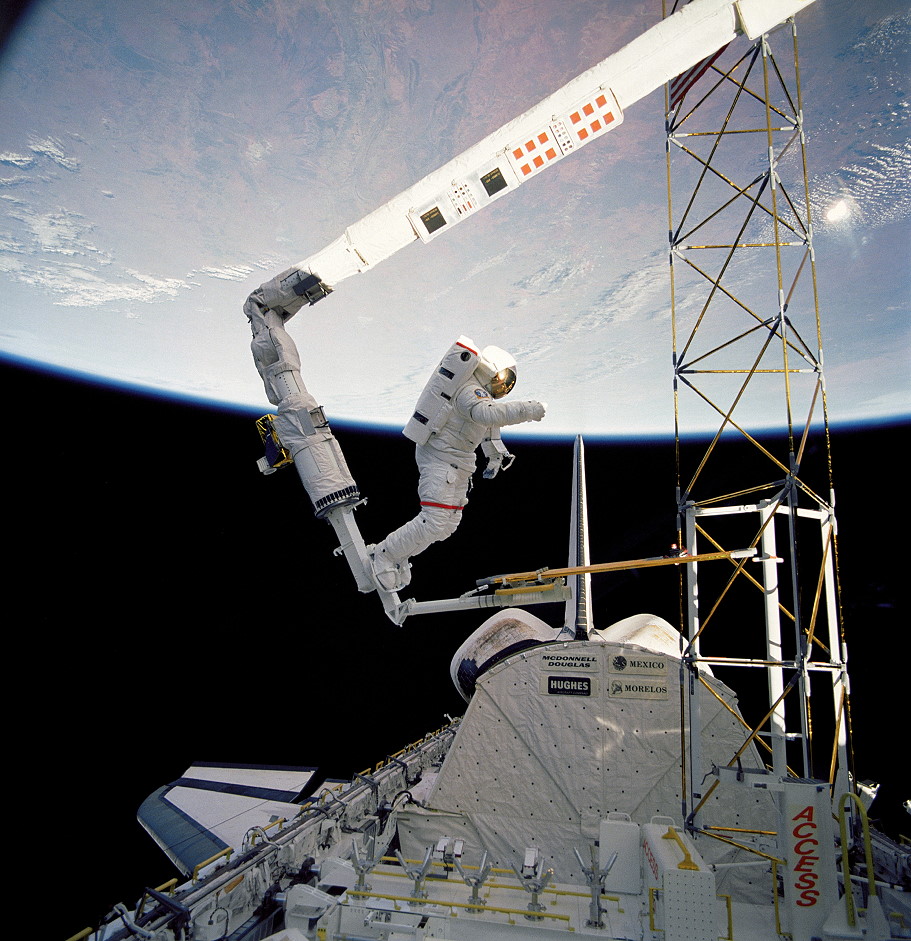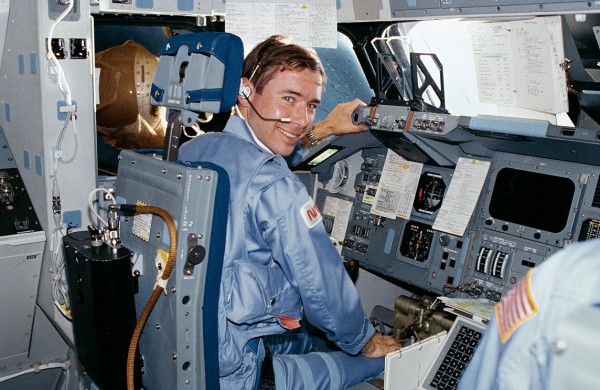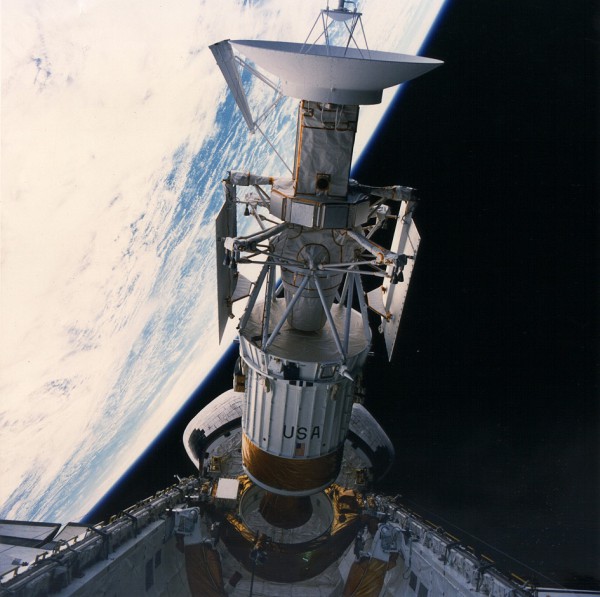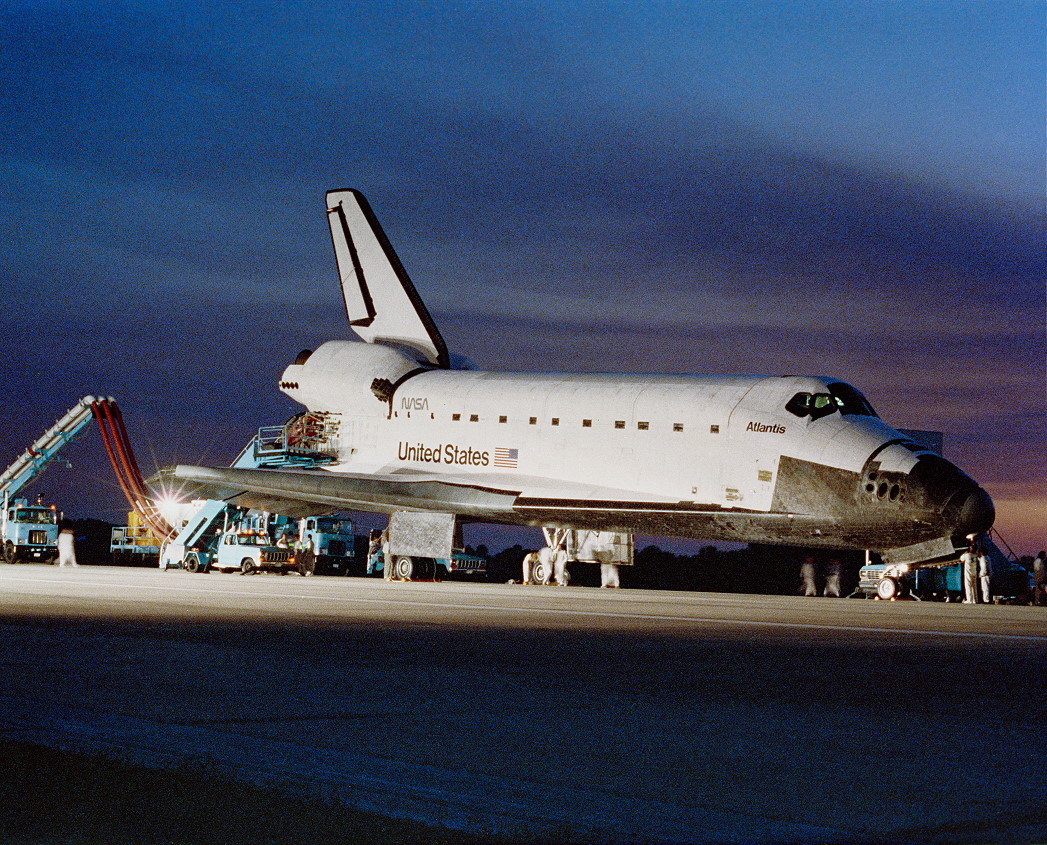
Thirty years ago, this week, five astronauts circled Earth on the maiden voyage of NASA’s fourth shuttle orbiter, Atlantis. However, as outlined in a previous AmericaSpace article, the crew of Mission 51J—Commander Karol “Bo” Bobko, Pilot Ron Grabe, Mission Specialists Dave Hilmers and Bob Stewart, and Air Force Manned Spaceflight Engineer (MSE) Bill Pailes—staged a four-day flight which hardly made the headlines, for it was totally dedicated to the Department of Defense and therefore cloaked in secrecy. Although it had been inferred prior to 51J’s launch that the crew would deploy a pair of Defense Satellite Communications Satellite (DSCS)-III military communications satellites, mounted atop a single, Boeing-built Inertial Upper Stage (IUS), images of the payload would not be declassified and released in the public domain for more than a decade. It was a strangely quiet start to an illustrious career which would see Atlantis visit space 33 times, visit the International Space Station (ISS) a dozen times, visit Russia’s Mir orbital outpost seven times and visit the Hubble Space Telescope (HST) on one occasion.
When Mission 51J concluded with a smooth landing at Edwards Air Force Base, Calif., on 7 October 1985, the successful completion of her maiden voyage was merely the prelude to an expansive career, which was expected to see her fly as many as four more times before the end of 1986. That run of flights got underway at 7:29 p.m. EST on 26 November 1985, when she roared into the night from Pad 39A at the Kennedy Space Center (KSC) in Florida, kicking off Mission 61B, which would deploy three communications satellites—one of which would utilize a new booster, the Payload Assist Module (PAM)-D2—and execute two complex spacewalks to rehearse Space Station Freedom assembly techniques. However, what was most notable about 61B was that Atlantis launched a mere 50 days after returning from 51J, thereby creating a landing-to-launch record for a single orbiter which would never be broken throughout the shuttle fleet’s history.
Notwithstanding the managerial and operational mindset which was prevalent within NASA prior to the 51L disaster, such a rapid turnaround time remains remarkable. Putting that into context across the entirety of the 30-year shuttle program, the next-fastest landing-to-launch turnaround of a single orbiter was 55 days, achieved by Challenger during the run-up to Mission 41C in the spring of 1984, whilst in the post-51L era the closest parallel was the exceptional case of STS-94, in which Columbia was rapidly recycled to refly the Microgravity Science Laboratory (MSL) mission in just 84 days in mid-1997.

After coming to a halt on the Edwards runway on 7 October, Atlantis was attached—via the Mate-Demate Device (MDD)—to the Boeing 747 Shuttle Carrier Aircraft (SCA) and undertook the cross-continental flight back to her Florida home. She alighted on the Shuttle Landing Facility (SLF) on 12 October and was immediately ensconced into Orbiter Processing Facility (OPF) Bay 1, where she spent just 27 days, prior to her rollover to High Bay 3 of the Vehicle Assembly Building (VAB) on 8 November for stacking onto her External Tank (ET) and twin Solid Rocket Boosters (SRBs). After only four days inside the VAB, she was rolled to Pad 39A, atop Mobile Launch Platform (MLP)-2, for final preparations, ahead of her second launch. And plugging this into the context of the entire shuttle program, the next-fastest pre-Challenger single-flow OPF turnaround was 30 days, achieved by Discovery as she was readied for Mission 51I, whilst the fastest post-Challenger single-flow OPF turnaround was 55 days, achieved by Atlantis in the run-up to her STS-45 mission in the spring of 1992.
Reaching orbit after the shuttle program’s second night launch, the seven-strong 61B crew—which included Atlantis’ youngest-ever commander, 40-year-old Brewster Shaw, together with Mexico’s first astronaut and Jerry Ross, who would go on to fly the vehicle a record-setting five times—set to work deploying three commercial payloads, notably Satcom K-2, which was the highest-powered domestic communications satellites in service at the time and required the services of the uprated PAM-D2 to reach Geostationary Transfer Orbit (GTO). Yet 61B will remain in popular consciousness for a pair of spectacular EVAs, performed by Ross and crewmate Sherwood “Woody” Spring to assemble a pair of structures in readiness for Space Station Freedom operations. The first was a 43-foot-tall (13-meter) tower, known as Assembly Concept for Construction of Erectable Space Structures (ACCESS), whilst the other was a large inverted tetrahedron, known as Experimental Assembly of Structures in EVA (EASE).
Seven days after leaving Earth, Atlantis touched down at Edwards, wrapping up the shuttle program’s ninth mission of 1985, another calendar-year record that would never again be duplicated. Her next flight, Mission 61G, was planned for May 1986 and would feature a crew of four deploying the Galileo spacecraft on a lengthy voyage to Jupiter. As outlined in a previous AmericaSpace history article, this four-day flight would have seen a four-strong crew release Galileo atop a controversial, liquid-fueled Centaur-G Prime upper stage. Atlantis had been fitted with Centaur-related plumbing and control systems during her construction, although NASA intended to roll her to Pad 39B in February 1986—just a few weeks after the launch complex had been vacated by Challenger on the ill-fated Mission 51L—for validation testing and fit checks with a “real” Centaur and a dummy Galileo in her payload bay. She would then have been removed from the pad for the “real” Galileo to be loaded and then transferred to Pad 39A in April. Interestingly, Mission 61G would also have seen Atlantis fly her Phase II Space Shuttle Main Engines (SSMEs), for the first time, at their 109-percent thrust rating, following a recommendation accepted by NASA in early January 1986. By launching at the “standard” 104 percent, it was argued, the heavy Galileo/Centaur combo could not have accommodated a full load of propellant, which would have restricted their margins for the Earth-escape maneuver.
Following the loss of Challenger, and taking into account fears over the safety reliability of the Centaur, the upper stage was canceled in June 1986 and Galileo would eventually fly atop a less powerful Inertial Upper Stage (IUS). Had 1986’s missions flown as intended, Atlantis might have flown twice more that year. The first occasion, Mission 61K in August, would possibly have marked only the second occasion in the shuttle program’s history that a crew of eight astronauts launched to and from orbit on the same flight. Led by Vance Brand—who, aged 55, might have been Atlantis’ oldest commander—the crew included Switzerland’s first man in space, Claude Nicollier, and was dedicated as the Earth Observation Mission (EOM)-1/2. It would have been the first (and only) occasion that a Spacelab “short module” would have flown aboard the shuttle, carrying instrumentation to support a pallet of eight atmospheric, particle, and solar physics experiments. Atlantis would then have rounded out 1986 by launching NASA’s showpiece Hubble Space Telescope (HST) in October, on Mission 61J, commanded by John Young, who might have become the first human to log seven discrete spaceflights. The flight was also destined for an altitude of 318 miles (512 km), higher than any previous shuttle had attained. Interestingly, in the late fall of 1985, Missions 61K and 61J actually switched places on the manifest, when it became clear that swelling program costs had pushed HST 30 percent over-budget and three months behind schedule.

With Challenger gone, an almost-three-year period of introspection gripped NASA, as the agency sought to resolve the cause of the disaster and return the remainder of the shuttle fleet back to flight operations. For Atlantis, one highlight came in October 1986, when she was rolled out to Pad 39B for seven weeks of testing of new weather-protection systems, together with astronaut proficiency activities, including an emergency egress exercise. Seven “rookie” astronauts—Frank Culbertson, Steve Oswald, Kathy Thornton, David Low, Pierre Thuot, Carl Meade, and Jay Apt—participated in these activities, after which the five veteran NASA crew members of Mission 61C performed a Terminal Countdown Demonstration Test (TCDT) in November.
A little more than two years passed before she flew her third mission into space. On 2 December 1988, she rocketed into orbit with a five-man crew—including Jerry Ross, the first human to fly Atlantis twice—to deploy a classified Lacrosse radar-imaging satellite on behalf of the Department of Defense, which reportedly malfunctioned and required the astronauts to re-rendezvous and assist with its repair. This has generated rumors over the years that a “secret” EVA was performed, although this has never been confirmed. STS-27 was also notable in that the orbiter sustained severe Thermal Protection System (TPS) damage during ascent, caused by a piece of ablative insulator which detached from the right-hand SRB. Inspections of Atlantis’ heat shield, using the Remote Manipulator System (RMS) mechanical arm revealed at least one missing TPS tile and widespread scarring, indicative of damage to hundreds of others, which extended toward the critical Reinforced Carbon-Carbon (RCC) of the Wing Leading Edges (WLEs). Against many odds, Atlantis survived re-entry, but after touchdown inspections revealed significant damage to no fewer than 707 tiles. Years later, STS-27 Commander Robert “Hoot” Gibson remarked that, had the orbiter been lost—on only the second post-51L mission—the consequences could have spelled the end of the shuttle program.
Fortuitously, Atlantis would not only fly again, but would fly multiple times, with her next voyages, in May and October 1989, featuring the deployment of the first planetary spacecraft ever launched from the shuttle. On STS-30—which, at just under 97 hours in duration, was the shortest flight in Atlantis’ entire career—Magellan was set on course for an extended radar-mapping expedition to Venus, whilst STS-34 directed Galileo on a convoluted journey to explore Jupiter and deposit an instrumented probe into the giant planet’s atmosphere. These flight were followed by a pair of classified Department of Defense assignments: STS-36 in February 1990, which reportedly deployed the “Misty” stealthy intelligence satellite, and STS-38, the following November, which released a Satellite Data Systems (SDS)-B military communications satellite and, reputedly, an optically stealthy “geolocation platform” or “inspector” satellite, known only as “Prowler.” The mission ended with the first post-Challenger landing back at the Cape, and also marked the shuttle program’s first night landing in Florida. Betwixt STS-36 and STS-38, Atlantis and her sister, Columbia, were grounded for several months in the summer of 1990, due to a series of seemingly inscrutable hydrogen leaks. Atlantis’ fifth and final dedicated Department of Defense mission, STS-44 in November 1991, successfully deployed a Defense Support Program (DSP) missile early-warning satellite and is notable in that its crew featured a U.S. Army imagery analyst, Tom Hennen, and that its planned 10-day duration was cut to seven days, due to an Inertial Measurement Unit (IMU) failure. STS-44 was led by Atlantis’ oldest-ever commander, Fred Gregory, who was five weeks shy of his 51st birthday when he brought the vehicle to a landing on 1 December 1991.

In spite of flying more dedicated Department of Defense missions than any of her sisters—Discovery flew three, Columbia flew one, and Challenger and Endeavour flew none—Atlantis’ career also involved a multitude of NASA payloads. In April 1991, she flew STS-37 and deployed the Compton Gamma Ray Observatory (CGRO), the second of four “Great Observatories” to explore the Universe across virtually the entire electromagnetic spectrum. The mission featured the first U.S. spacewalk since before the loss of Challenger, when Jerry Ross (making a record third flight on Atlantis) and Jay Apt performed two EVAs to evaluate Space Station Freedom locomotion tools and were unexpectedly called upon to free a jammed antenna on CGRO, which, at 37,000 pounds (17,000 kg), represented one of the largest and most massive spacecraft yet deployed by the shuttle. Four months later, in August, she deployed a NASA Tracking and Data Relay Satellite (TDRS) on STS-43 and spent almost nine days aloft, marking her longest mission to date. That envelope was stretched further in March 1992, although by barely an hour, when she again spent nine days in space with the first Atmospheric Laboratory for Applications & Science (ATLAS-1) laboratory on STS-45. This mission not only represented Atlantis’ first dedicated science mission, but also many of the ATLAS-1 payloads were carried over from the pre-Challenger EOM-1/2 flight.
Following her STS-46 mission in July 1992—which deployed the joint U.S./Italian Tethered Satellite System (TSS) and the European Retrievable Carrier (EURECA) scientific payloads, as well as transporting the first national astronauts of Switzerland and Italy into orbit—Atlantis had more than 10 weeks of cumulative time spent in space, spread across 12 missions, and was closing in on an extended period of maintenance and refurbishment. Originally, this was expected to involve a relatively benign series of upgrades and modifications, but for Atlantis she would prove to have been in the right place at the right time, for the first contracts of co-operation between the United States and Russia were in the process of being negotiated. As will be explored in tomorrow’s article, Atlantis would assume center-stage in the shuttle-Mir program, before taking a starring role in the International Space Station (ISS).
The fourth part of this five-part article will appear tomorrow.
Want to keep up-to-date with all things space? Be sure to “Like” AmericaSpace on Facebook and follow us on Twitter: @AmericaSpace




The tiles on the OMS pods in that first picture sure do look like they took a pounding from the previous (maiden) flight. Was that something they just didn’t bother replacing until later missions?